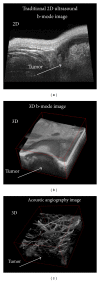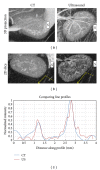Acoustic angiography: a new imaging modality for assessing microvasculature architecture
- PMID: 23997762
- PMCID: PMC3730364
- DOI: 10.1155/2013/936593
Acoustic angiography: a new imaging modality for assessing microvasculature architecture
Abstract
The purpose of this paper is to provide the biomedical imaging community with details of a new high resolution contrast imaging approach referred to as "acoustic angiography." Through the use of dual-frequency ultrasound transducer technology, images acquired with this approach possess both high resolution and a high contrast-to-tissue ratio, which enables the visualization of microvascular architecture without significant contribution from background tissues. Additionally, volumetric vessel-tissue integration can be visualized by using b-mode overlays acquired with the same probe. We present a brief technical overview of how the images are acquired, followed by several examples of images of both healthy and diseased tissue volumes. 3D images from alternate modalities often used in preclinical imaging, contrast-enhanced micro-CT and photoacoustics, are also included to provide a perspective on how acoustic angiography has qualitatively similar capabilities to these other techniques. These preliminary images provide visually compelling evidence to suggest that acoustic angiography may serve as a powerful new tool in preclinical and future clinical imaging.
Figures








References
-
- Carmeliet P. Angiogenesis in life, disease and medicine. Nature. 2005;438(7070):932–936. - PubMed
-
- Li C-Y, Shan S, Huang Q, et al. Initial stages of tumor cell-induced angiogenesis: evaluation via skin window chambers in rodent models. Journal of the National Cancer Institute. 2000;92(2):143–147. - PubMed
-
- Schambach SJ, Bag S, Groden C, Schilling L, Brockmann MA. Vascular imaging in small rodents using micro-CT. Methods. 2010;50(1):26–35. - PubMed
Grants and funding
LinkOut - more resources
Full Text Sources
Other Literature Sources

